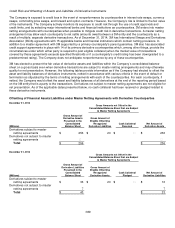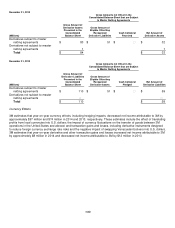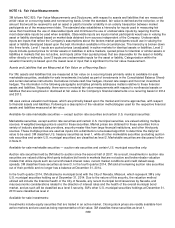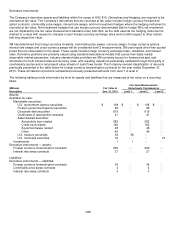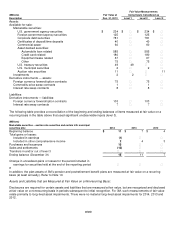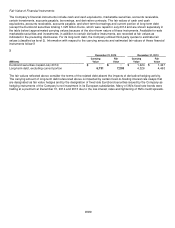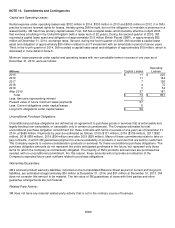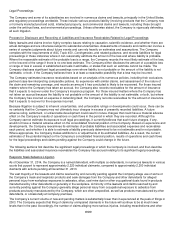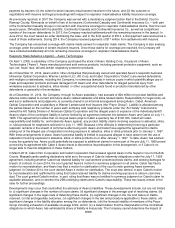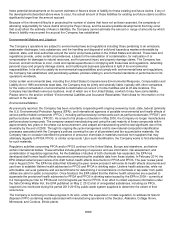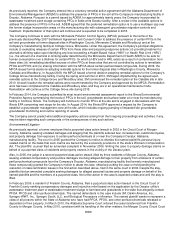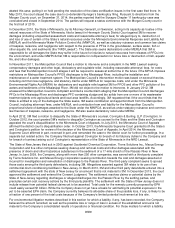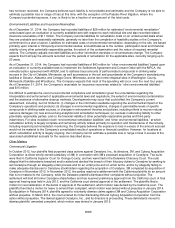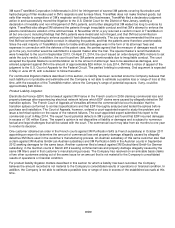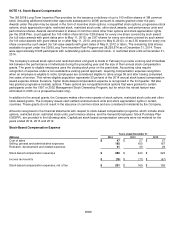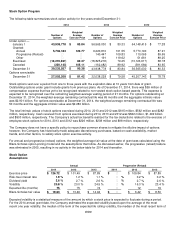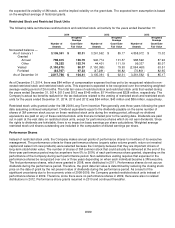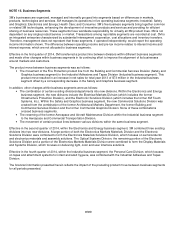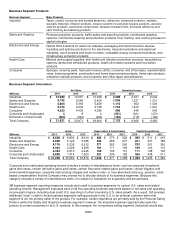3M 2014 Annual Report Download - page 112
Download and view the complete annual report
Please find page 112 of the 2014 3M annual report below. You can navigate through the pages in the report by either clicking on the pages listed below, or by using the keyword search tool below to find specific information within the annual report.
106
these potential developments on its current estimate of Aearo’s share of liability for these existing and future claims. If any of
the developments described above were to occur, the actual amount of these liabilities for existing and future claims could be
significantly larger than the amount accrued.
Because of the inherent difficulty in projecting the number of claims that have not yet been asserted, the complexity of
allocating responsibility for future claims among the Payor Group, and the several possible developments that may occur
that could affect the estimate of Aearo’s liabilities, the Company cannot estimate the amount or range of amounts by which
Aearo’s liability may exceed the accrual the Company has established.
Environmental Matters and Litigation
The Company’s operations are subject to environmental laws and regulations including those pertaining to air emissions,
wastewater discharges, toxic substances, and the handling and disposal of solid and hazardous wastes enforceable by
national, state, and local authorities around the world, and private parties in the United States and abroad. These laws and
regulations provide, under certain circumstances, a basis for the remediation of contamination, for restoration of or
compensation for damages to natural resources, and for personal injury and property damage claims. The Company has
incurred, and will continue to incur, costs and capital expenditures in complying with these laws and regulations, defending
personal injury and property damage claims, and modifying its business operations in light of its environmental
responsibilities. In its effort to satisfy its environmental responsibilities and comply with environmental laws and regulations,
the Company has established, and periodically updates, policies relating to environmental standards of performance for its
operations worldwide.
Under certain environmental laws, including the United States Comprehensive Environmental Response, Compensation and
Liability Act of 1980 and similar state laws, the Company may be jointly and severally liable, typically with other companies,
for the costs of remediation of environmental contamination at current or former facilities and at off-site locations. The
Company has identified numerous locations, most of which are in the United States, at which it may have some liability.
Please refer to the section entitled “Environmental Liabilities and Insurance Receivables” that follows for information on the
amount of the accrual.
Environmental Matters
As previously reported, the Company has been voluntarily cooperating with ongoing reviews by local, state, federal (primarily
the U.S. Environmental Protection Agency (EPA)), and international agencies of possible environmental and health effects of
various perfluorinated compounds (“PFCs”), including perfluorooctanyl compounds such as perfluorooctanoate (“PFOA”) and
perfluorooctane sulfonate (“PFOS”). As a result of its phase-out decision in May 2000, the Company no longer manufactures
perfluorooctanyl compounds. The company ceased manufacturing and using the vast majority of these compounds within
approximately two years of the phase-out announcement, and ceased all manufacturing and the last significant use of this
chemistry by the end of 2008. Through its ongoing life cycle management and its raw material composition identification
processes associated with the Company’s policies covering the use of all persistent and bio-accumulative materials, the
Company has on occasion identified the presence of precursor chemicals in materials received from suppliers that may
ultimately degrade to PFOA, PFOS, or similar compounds. Upon such identification, the Company works to find alternatives
for such materials.
Regulatory activities concerning PFOA and/or PFOS continue in the United States, Europe and elsewhere, and before
certain international bodies. These activities include gathering of exposure and use information, risk assessment, and
consideration of regulatory approaches. As the database of studies of both chemicals has expanded, the EPA has
developed draft human health effects documents summarizing the available data from these studies. In February 2014, the
EPA initiated external peer review of its draft human health effects documents for PFOA and PFOS. The peer review panel
met in August 2014. The EPA has stated that following the peer review process it will revise its health effects documents and
use them to establish lifetime health advisories for PFOS and PFOA in drinking water. Lifetime health advisories, while not
enforceable, serve as guidance and are benchmarks for determining if concentrations of chemicals in tap water from public
utilities are safe for public consumption. Once finalized, the EPA stated that the lifetime health advisories are expected to
supersede the provisional health advisories for PFOA and PFOS in drinking water issued by the EPA in 2009 – currently at
0.4 micrograms per liter for PFOA and 0.2 micrograms per liter for PFOS. In an effort to collect exposure information under
the Safe Drinking Water Act, the EPA published on May 2, 2012 a list of unregulated substances, including six PFCs,
required to be monitored during the period 2013-2015 by public water system suppliers to determine the extent of their
occurrence.
The Company is continuing to make progress in its work, under the supervision of state regulators, to address its historic
disposal of PFC-containing waste associated with manufacturing operations at the Decatur, Alabama, Cottage Grove,
Minnesota, and Cordova, Illinois plants.


